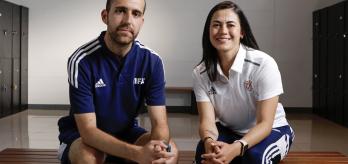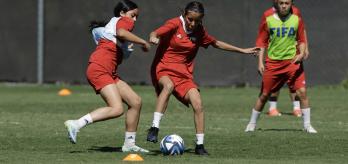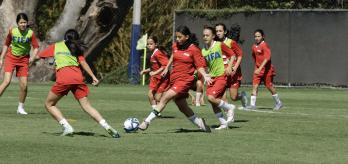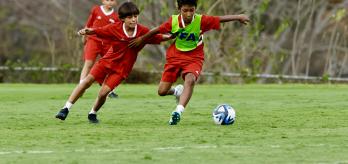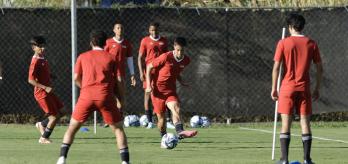The majority of teams in the modern game are coached to build play up from the back and progress through the thirds. Applying a high press or setting up in a mid-block are effective methods to prevent the opposition from doing so. However, unless executed in an organised way, such strategies often prove futile. By retaining a compact defensive shape that is based on the ball carrier’s positioning and passing options, a team are able to shut down central areas and prevent the opposition from progressing play.
In this session, FIFA Talent Coach Claudio García and Costa Rican Football Association Talent Coach Lina Arana deliver a series of passing drills and games to a group of girls. The session primarily focuses on blocking and preventing the opponent from playing through central areas. Players work mainly in units during various exercises to gain a better understanding of working together to prevent the opponent from playing forward. The session concludes with a team game where players are asked to incorporate all the principles practiced in the previous exercises into a real-game scenario.
Session overview
Key coaching points
-
By approaching the receiving player side-on and arching their runs, pressing players can limit opposing players’ passing options.
-
Pressing players should force ball carriers into wide areas or force turnovers by making the central area compact and shutting off inside passing lanes.
-
When a player presses the ball carrier, their team-mates must be ready to cover their passing options and shut off passing lanes.
-
When the in-possession team lose the ball, it should immediately trigger a change in mindset amongst the players from attack to defence, with players pressing aggressively and intelligently.
-
When pressing high up the pitch, pressing players should be aware of the movement behind them in case the press is bypassed.
Part 1: passing circuit
The first exercise focuses on a player level and involves a passing activation to get the players warmed up while working on their passing skills and defensive technique.
-
Mark out two 10m x 10m diamond-shaped circuits.
-
Split the players into 2 groups of 8 and assign each group to a circuit.
-
Place 2 players at each cone.
-
The exercise begins with the player with the ball taking a touch before passing to the player next to them in a clockwise direction.
-
The receiving player performs the same action to continue the sequence.
-
As soon as a pass is played, the player positioned at the cone opposite the receiving player sprints out from their station to put them under pressure.
-
Once the receiving player has played the ball to the next player in the sequence, the pressing player goes to the back of the queue at the cone where they just applied the press.
-
Receiving players should not play the pass to the next player in the sequence until the pressing player has reached them.
-
Once the circuit has been completed a number of times, the sequence should be switched and performed in an anticlockwise direction.
-
Pressing players must sprint towards the receiving player and press aggressively.
-
Pressing players should approach the receiving player side-on and arch their runs to shut off passing lanes.
-
Pressing players should get to within arm’s reach of the receiving player to give them a chance of intercepting their pass.
-
Receiving players should take a firm first touch and play the ball to their team-mate’s back foot to aid the fluidity of the sequence.
-
Encourage players to progressively increase their speed of execution.
Part 2: 4v2 possession game
This possession drill works on a unit level and aims to improve the players’ ability to defend in pairs. The exercise also presents the players with an opportunity to practise keeping the ball when under pressure in tight spaces.
-
Mark out two 25m x 15m exercise areas.
-
Split the players into 2 groups: one comprising 9 players and the other containing 8 players.
-
Assign the group with 8 players to exercise area A and the group with 9 players to exercise area B.
-
Arrange the players in each group into pairs (greens, blues, oranges and yellows).
-
The spare player in exercise area B acts as a neutral player.
-
The exercise begins with the blues as the pressing team, and the oranges and greens look to keep the ball between themselves in one half of the exercise area and transfer possession to the yellows, who are located in the opposite half.
-
If the blues win possession, they pass the ball to the pair positioned in the opposite half of the exercise area, with the pair who gave away possession becoming the pressing team and the blues working with the other 2 teams to retain possession.
-
Pressing players must coordinate their press. The player closest to the ball carrier should press first, with their team-mate asked to cover and anticipate where the next pass may be played.
-
Pressing players should force the play wide, using the touchline as an extra defender to limit the ball carrier’s passing options.
-
After losing possession, players need to quickly switch their mindset from attack to defence.
-
Pressing players must press aggressively and adopt a side-on body shape to reduce the time that the opposition have on the ball and their options.
Part 3: 4v4 small-sided game
This small-sided game works on a unit scale and focuses on the defensive coordination of a line of press. The exercise can be applied to any phase of the press but focuses primarily on containing the opposition and preventing them from playing through the press.
-
Set up two 25m x 25m exercise areas, marking out a halfway line and 3 equally sized channels in each area.
-
Position 2 mini-goals at either end of each exercise area.
-
Split the players into 3 teams of 4 and 1 team of 5.
-
Set up a 4v4 scenario in exercise area A (oranges v. blues) and a 5v4 scenario (oranges v. blues) in exercise area B.
-
Arrange the teams of 4 into a 3-1 formation and the team of 5 in a 4-1 system.
-
Distribute the players equally across the 3 channels.
-
A coach plays the ball into one of the teams.
-
The striker occupies a position behind the opposition’s defensive line, while their team-mates must remain in their own half when their team are in possession.
-
The in-possession team’s objective is to circulate the ball and score into either mini-goal. They can do so by shooting from inside their own half or linking up with the striker.
-
The out-of-possession team must coordinate their press to try to win the ball.
-
Players on the out-of-possession team can enter the in-possession team’s half.
-
If the out-of-possession team win the ball, the two teams immediately swap roles.
-
The out-of-possession team must coordinate their movement to apply an effective press, cover for each other and retain good balance in relation to the ball carrier.
-
When applying the press, out-of-possession players must be mindful of the movement behind them to avoid leaving the striker free.
-
As soon as possession is lost, out-of-possession players must quickly switch their mindset to defend aggressively.
-
The in-possession team must look to circulate the ball quickly to avoid being pressed, while also creating passing lanes to play into the striker.
-
Strikers must play on the defenders’ shoulders and move along the defensive line
Part 4: 4 plus 1 v2 possession game
This possession game works on a unit level and involves creating 4v2 scenarios in small zones to allow players to hone their defensive skills when pressing and shutting off passing lanes.
-
Mark out a 30m x 30m exercise area and divide it into 4 equally sized zones.
-
Split the group into 4 teams of 4 (blues, oranges, greens and yellows).
-
Place 3 of the teams (blues, greens and oranges) in a zone each.
-
The other team (yellows) start as the defending team and join one of the 3 teams (blues) in a zone.
-
Assign 3 neutral players: a goalkeeper positioned at each end of the exercise area (light green) and a player who operates inside the exercise area (grey).
-
The objective of the exercise is to create 4+1v2 scenarios in each of the 4 zones in turn.
-
The exercise starts with any of the 3 attacking teams in possession.
-
The defending team press the attacking team in the zone.
-
Two defending players actively press the ball and the other 2 defending players shut off the passing lanes into the adjacent zones.
-
The attacking team must complete 3 passes before being able to transfer possession to one of the teams waiting to receive the ball in an adjacent zone.
-
If the attacking team manage to complete 3 passes, the defending team move to press the attacking team in the adjacent zone into which the ball has been played.
-
The out-of-possession attacking team move into the unoccupied zone in readiness to receive the ball.
-
An attacking team can only pass the ball into an adjacent zone (and not into a diagonal zone).
-
If an attacking team lose possession, they immediately switch roles with the defending team.
-
The neutral players are limited to 3 touches.
-
Players must recognise whether they should press aggressively or cover and cut off passing lanes.
-
When cutting off passing lanes, defenders must anticipate the pass that the ball carrier is most likely to play.
-
Pressing players should approach the receiving player side-on and arch their runs to shut off passing lanes.
-
Players must play firm, precise passes that are played to the foot that allows the receiving player to evade the opposition’s press.
Part 5: 7v7 plus 3 team game on a reduced-sized pitch
This final game works on a team level, and the players are asked to apply all of the defensive skills practised in the previous exercises. The drill aims to replicate scenarios in which the defending team apply a coordinated press to prevent the opposition from playing through central areas.
-
Mark out a 60m v 50m exercise area.
-
Position a full-size goal at each end of the exercise area.
-
Place a goalkeeper in each goal.
-
Split the group into 2 teams of 7 (oranges v. blues) and assign 3 neutral players (greys).
-
Set up a 7v7 scenario.
-
Set the blues up in a 3-2-2 formation.
-
Arrange the oranges in a 4-2-1 system.
-
The in-possession team can use the 3 neutral players to create a 10v7 scenario.
-
The neutral players should operate in central areas at all times.
-
The in-possession team’s objective is to score, and the out-of-possession team aim to regain possession.
-
The out-of-possession team must stay compact and avoid affording the opposition the space to move or play into.
-
Forward players should press aggressively, with the team-mates behind them ready to step up and shut off passing lanes.
-
When the in-possession team are building up play, the out-of-possession team should press central areas and force the opposition wide.
-
When the ball is in a wide area, the out-of-possession team should close play down on one side of the exercise area to force a turnover.
-
When the in-possession team lose the ball, players must regain their defensive shape immediately and stay compact.





